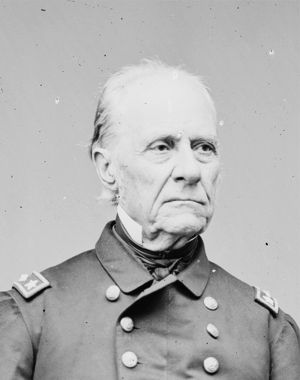
Libraru of Congress photo.
Rear Admiral William Bradford Shubrick by Matthew Brady.
After duty in Hornet early in the War of 1812, he was assigned to Constellation and, while that frigate was at Norfolk, he led a party of bluejackets in beating off a British boat attack against Craney Island on 22 June 1813. He subsequently was awarded a Congressional medal for service in Constitution during her capture of Cyane and Levant.
During the more than three decades separating the War of 1812 from the Mexican War, Shubrick commanded, in turn, Lexington and Natchez; directed operation of the West Indies Squadron from 1838 to 1840; and headed the Bureau of Provisions and Clothing from 1845 to 1846.
At the outbreak of the war with Mexico, Shubrick requested sea duty and, in Independence, sailed for the California coast to relieve Commodore Sloat in command of American naval forces there. However. Commodore James Biddle brought his East India Squadron to Monterey, California on 2 January 1847—only a week after Shubrick's arrival—and assumed command. In April, Shubrick sailed for the coast of Mexico to head the blockade of Mazatlan and Guaymas. Early in June, Shubrick was recalled to California where Biddle restored him to overall command on 19 July and sailed for the east coast.
Under Shubrick, the Navy successfully conducted the closing operations of the war on the Pacific coast. Highlights were the capture of Guaymas in October and of Mazatlan in November. San Bias fell in January 1848.
The following spring, Shubrick headed home and took command of the Philadelphia Navy Yard in 1849. He subsequently headed the Bureau of Construction and Repair. In August 1852, he became chairman of the Lighthouse Board.
In October 1858, Shubrick sailed in command of the fleet sent to South American waters to support diplomatic efforts to resolve differences with Paraguay resulting from the firing upon the USS Waterwitch.
In December 1861, Shubrick was retired; and he was promoted to rear admiral on the retired list on 16 July 1862. He died in Washington, D.C., on 27 May 1874.
Source: Naval History & Heritage Command including Dictionary of American Naval Fighting Ships.